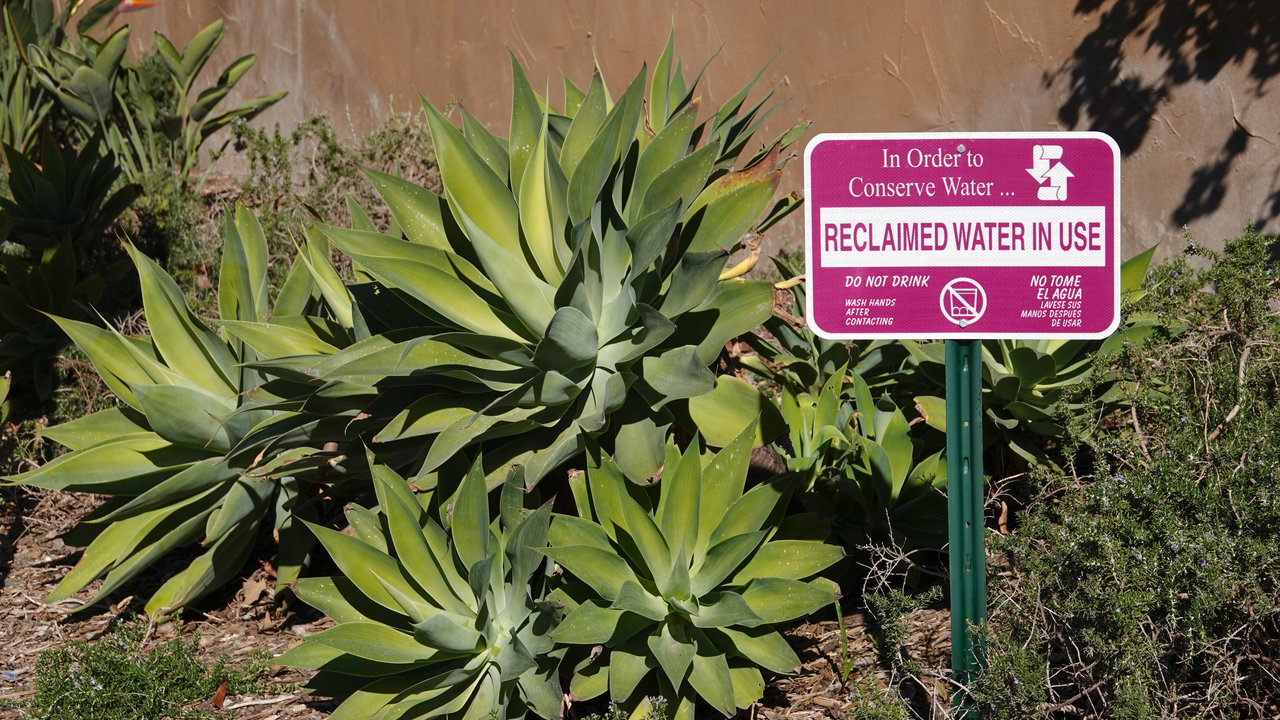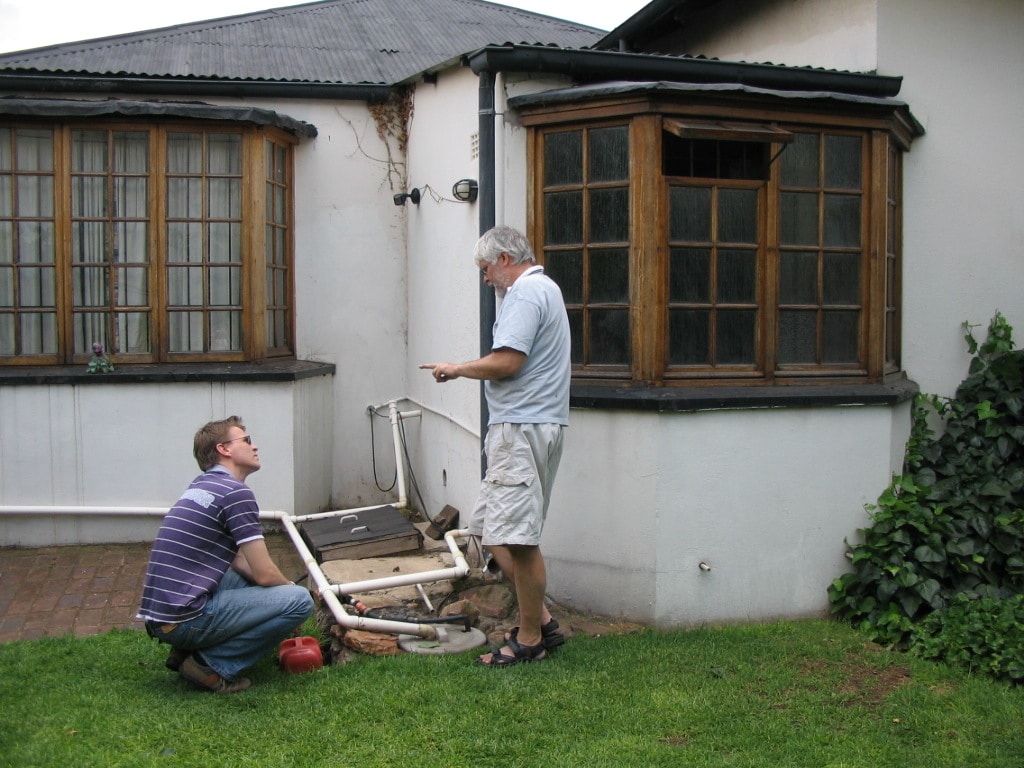
Imagine that instead of flowing into the sewer system, water discharged by your bathtub, dishwasher, kitchen sink and washing machine was pumped instead into your landscape.
The systems that perform this task are called greywater systems (also spelled graywater, grey water and gray water). They sound eco-friendly and resource-conserving, and they are. Whether they’re right for you depends on your appetite for a parallel plumbing system in your home.
What are Greywater Systems?
Greywater Action, a group that promotes greywater systems, defines it as “gently used water from your bathroom sinks, showers, tubs, and washing machines. It is not water that has come into contact with feces, either from the toilet or from washing diapers.” An estimated 60% of used household water is greywater.
Greywater may contain traces of dirt, flakes of skin, food, oils, or grease. If not used within days, it turns foul. That sounds undesirable (and downright unsafe) for drinking or further washing — so much so that many states ban its use. However, where it’s legal it has strong advocates, who argue that gently used water can still serve a very good purpose: watering plants.
Potential Savings
Arizona is an example of a state where water is a precious resource, water conservation critical. The state regulates and permits any greywater reuse. Those that discharge 400 gallons per day, a category that would include most individual household systems, are lightly regulated. The state restricts greywater use to irrigation purposes and requires that greywater be contained within the permit-holder’s property (see chart below of state regulations).
“Users of greywater can save money [on] their regular water bill while also helping ensure Arizona’s water supply,” says David Dunaway, manager of the Aquifer Protection Permit program Arizona’s Department of Environmental Quality. “Using greywater ultimately saves money and energy, and reduces the strain on the city’s potable water supply.”
Potable water requires energy and resources to purify at a treatment plant. After that, it burns up even more resources during transit to the urban areas where water resources are needed. We all pay for that purification and transportation through our water bills.
Advocates of greywater systems point out that in addition to helping preserve scarce resources, you could save on your water bill by reusing non-potable water. Estimates of savings run from $300 to $600 per year.
This can be an immense environmental burden — especially in dry, desert regions like Arizona. “Arizona is dependent on water from the Colorado River and our limited supply of groundwater,” said Dunaway. “Using graywater for landscaping helps offset the need for otherwise potable water.”

Challenges of Greywater Systems
In theory, if everyone used a gray water system, it would reduce pressure on natural resources. But anyone considering the move needs to know the challenges.
Greywater systems are inaccessible to most people owing to:
- Complexity
- Installation
- Costs
- Legality
- Safety
Complexity
Unless you’re a plumber, this isn’t a DIY job. Even the most basic systems usually require entirely new parallel wastewater systems to be installed alongside your existing main water lines.
A rudimentary greywater system for irrigation will divert the greywater drain from your tub, your sink, your dishwasher, or your clothes washer to a watering tube or hose outside of your home.
The way most houses are plumbed, greywater mixes with “blackwater” (aka sewage from your toilet) in the same line. The exception: the drainage line for most washing machines is separate, and is also considered the best sources of greywater for watering plants.
Even conveniently filling a watering can with greywater after a bath could require an elaborate re-rigging of one’s plumbing.
To adequately water one’s lawn using a user-friendly greywater system, on the other hand (which needs sprinklers or drip irrigation and cannot be watered with a watering can), requires yet more labor to use than that, specifically when it comes to installation.
Installation
While some are simple enough to be DIY projects, most types of greywater systems require professional installation.
This even goes for the simple diversion of greywater away from your blackwater for filling a watering can, all the way to the complex plumbing (and even underground drip irrigation tubing) required to irrigate your lawn with greywater.
Both these (whether using or installing the system yourself) are not easy tasks, with many ways they could go wrong without the help of a pro at your side.
Still, some experts suggest there are ways it can be done easily — though when you read between the lines, it will still demand some good plumbing intuition and know-how.
A greywater system can range “from a quick weekend project that involves only one trip to a home improvement store to [buying and installing] technically advanced water recycling systems,” said Dunaway. “It depends on the type of system a homeowner sets up, and the type and quantity of plants. Simple and cheap projects have an easier time recuperating costs.”
Cost
If you haven’t put it together yet, getting a greywater system installed by a professional will cost you — if you want it done quickly and done right.
According to Remy Sabiani, owner of Water Wise Group (and speaking about his company’s own greywater systems, Aqua2use), “Prices start at $399. Our systems can be installed by any plumber, and it usually takes 3-4 hours for a complete setup.”
This can be a considerable chunk of change for the average person. Systems that include pumps, treatment systems, filtering tanks and subsurface irrigation, quickly boost costs to $10,000 or more.
Legal Issues
Before even considering the costs and labor of setting up a system, you’ll need to look into your state’s codes. Fourteen states define greywater as wastewater. Another 10 treat greywater as septic, and regulate it like discharge from a septic system. The chart below lists how states regulate greywater (and in some cases, don’t).
| State Regulations of Greywater Systems | |
|---|---|
| States that define greywater as wastewater | Alabama, Alaska, Arkansas, Colorado, Delaware, Indiana, Iowa, Louisiana, Mississippi, Missouri, Oklahoma, Pennsylvania, Rhode Island, Vermont |
| States with no definition of greywater | Illinois, Kansas, North Dakota, Ohio, South Carolina, Tennessee |
| States treating greywater as septic discharge | Connecticut, Kentucky, Maryland, Michigan, Minnesota, Nebraska, New Hampshire, New Jersey, New York, West Virginia |
| States permitting greywater using a tiered approach* | Arizona, California, New Mexico, Oregon, Washington |
| States regulating greywater reuse without a tiered approach | Florida, Georgia, Montana, Massachusetts, North Carolina, South Dakota Texas, Utah, Virginia, Wisconsin, Wyoming |
| States allowing residential irrigation only | Hawaii, Idaho, Maine, Nevada |
| *States using a tiered approach apply different regulations to differently sized greywater systems. Source: "Treatment, Public Health and Regulatory Issues Associated with Greywater Reuse" |
|
Safety
Is using greywater 100% safe? According to Art Ludwig of Oasis Design, an ecological design company in Santa Barbara, Calif., greywater lawn irrigation may pose some safety hazards, though they seem minimal.
Any time people walk on landscape watered with greywater, you are “inviting direct contact with untreated greywater and the possibility of transmitting pathogens,” says Ludwig. “The likelihood of transmitting disease is small … but it exists.”
Food crops, especially vegetables, should not utilize greywater. The exception: a fruit or vegetable with above-ground fruit that never directly contacts a drip irrigation setup.
However, Sabiani of Water Wise Group points out that other plants will benefit from the contents of greywater, and not be affected by its pathogens.
“You don’t have to worry about greywater systems harming your plants,” said Sabiani. In fact, “greywater systems leave some soap in the filtered water because it encourages growth and adds nutrients to your garden’s soil.”
Landscape, Yes. Lawns, Probably Not
The consensus on the most economical way to use greywater for the average person: Divert laundry water from your washing machine and use it to save money on irrigating trees, shrubs, and other nonfood plants in your yard.
Laura Allen is a co-founder of Greywater Action, a collaborative that promotes and educates about greywater systems. Said Allen, “Most greywater systems cannot irrigate a lawn.
“So, my advice would be to consider having less lawn,” she added, “and instead irrigate trees and shrubs with a simple greywater system.”
Says Ludwig, “The only proven safe and reliable way of irrigating lawns with greywater is through underground drip tubing supplied by a backwashing sand filter type system; far beyond what most residences are likely to install.”
Simplest Greywater System of All: Reuse Warmup Water
If the prospect of a full landscape irrigation system using greywater is too daunting, experts advise taking one simple step that won’t require anything more complex than a bucket: Reuse your sink warmup water. When you’re running the water at the kitchen sink, waiting for it to warm up, catch it in a bucket. Use the fresh water later on your plants.
If you need help choosing and installing a greywater system, call a local landscape expert to help you out.